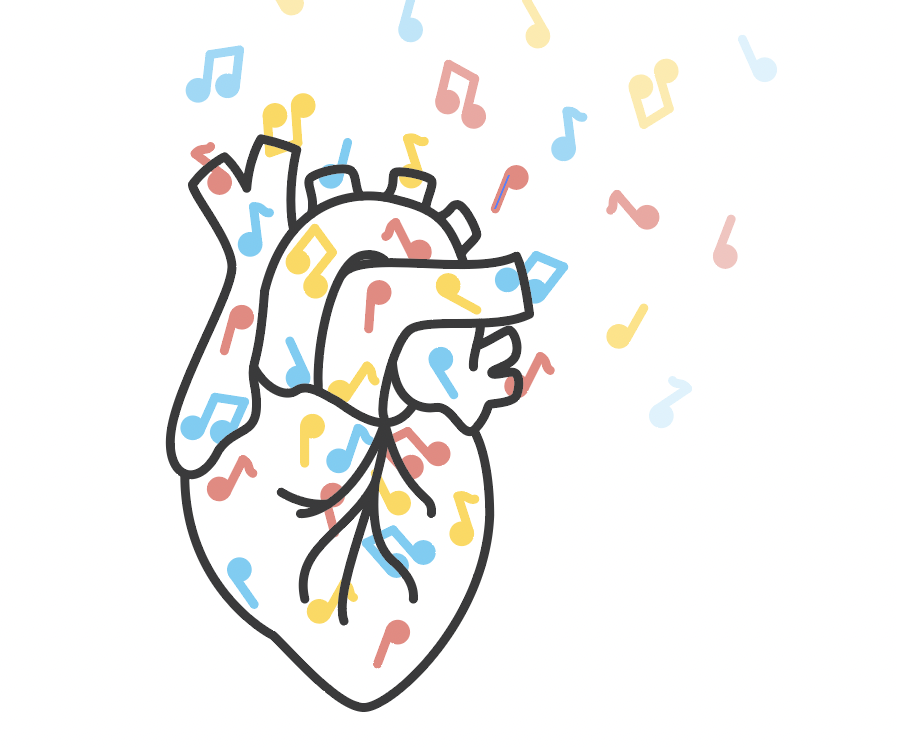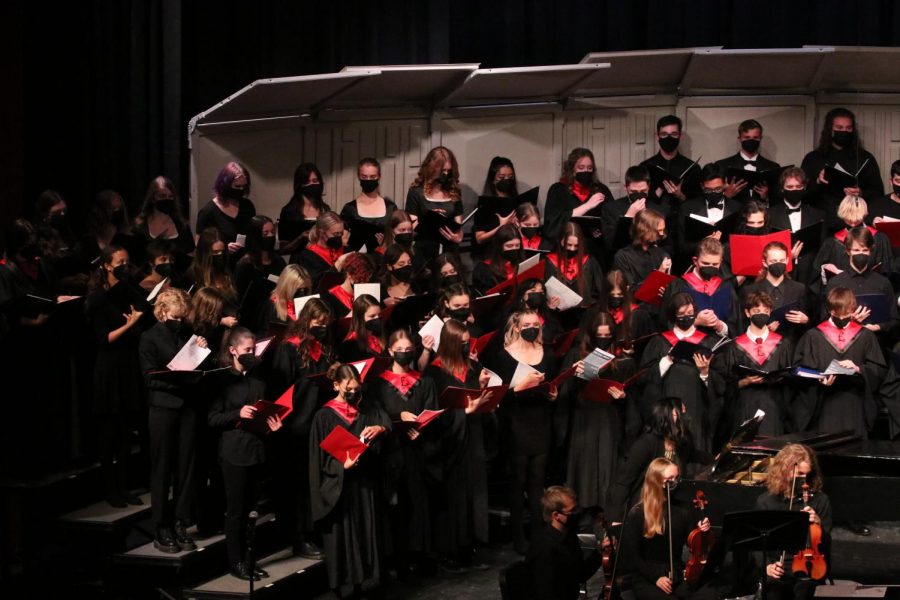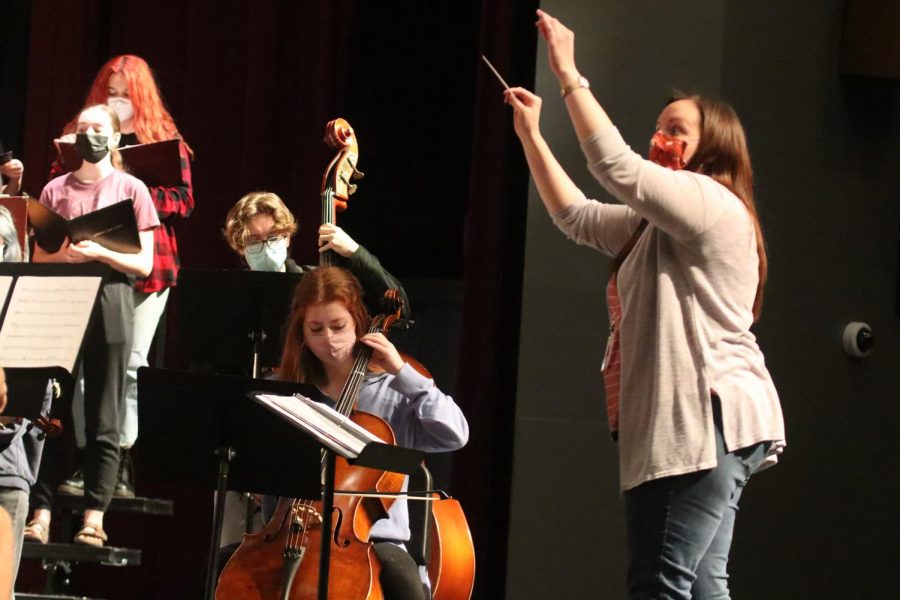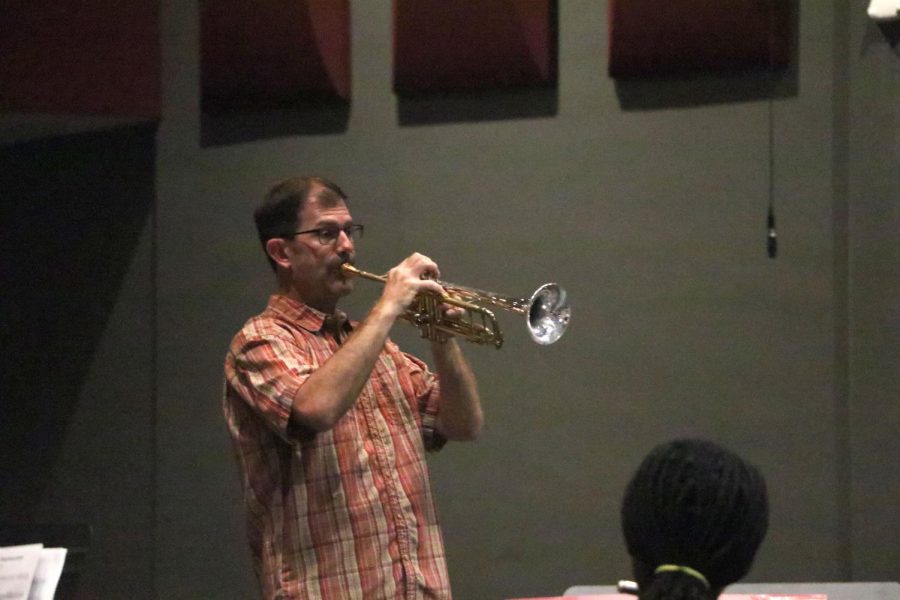Making Music Matters
The return of music performance may come at just the right time to remedy a mental health crisis
December 13, 2021
As Lawrence High School’s A Cappella choir cuts off its final note the crowd erupts into cheers.
Almost everyone in the auditorium has a smile on their face. Parents, proud to hear their children perform, giddily hold up their cameras trying to get the perfect photo of their child dressed in a tux or dress on stage.
Other community members are just happy to finally hear live music being performed again after COVID-19 forced a long respite from the melodies and harmonies.
But of everyone in the packed auditorium, it’s students that have the biggest grins. Multiple of them with tears running down their faces. This is the moment many of them have missed the most during the pandemic and subsequent quarantines and lockdowns.
“At the end of the first choir concert of the school year I felt myself tear up onstage and then straight up cry,” said senior Sofia Thomas. “I was just so happy to be singing with my peers again, and when Dr. Dunn looked at us with such pride for our musical accomplishment I felt so joyful and ecstatic to be making music with Chorale and A Cappella Choir. Singing a beautiful song of hope after a year of isolation was one of the happiest moments of my life.”
You need look no deeper than the lyrics they just sang to understand exactly how these students feel.
The final song of their program that night was called “And for a breath…” by composer Ryan Main. Main is from the Kansas City area and worked directly with the A Cappella Choir to prepare the piece for their upcoming performance as an honor choir at the Kansas Music Educators Association convention in February.
The lyrics for the song are taken from the poem “Barter” by Sara Teasdale, ring louder than the last note bouncing off the back wall.
“Life has loveliness to sell,
Music like a curve of gold,
Scent of pine trees in the rain,
Eyes that love you, arms that hold,
And for your spirit’s still delight,
Holy thoughts that star the night.
Spend all you have for loveliness,
Buy it and never count the cost;
For one white singing hour of peace
Count many a year of strife well lost,
And for a breath of ecstasy
Give all you have been, or could be.”
– Barter by Sara Teasdale
One white singing hour of peace. Or one and a half. Dr. Dwayne Dunn’s choir concerts aren’t notorious for being short. But most certainly a singing hour and a half of peace.
Count many a year of strife well lost. The past year was most certainly a year of strife. Especially for those who thrive with performance, an act that has been nonexistent during the majority of the COVID-19 pandemic.
The year of strife has melted from the minds of every performer on stage. They are finally back. Music is finally back.
For many, fine arts classes are a place of refuge. A shelter in the storm can be high school. The tireless barrage of classes and homework, the stresses of interacting with a complex social environment and the intensity and confusion that is being a high schooler during a global pandemic.
But for the 52 minutes that the students are singing, marching, playing or creating, it doesn’t really matter. One breath of ecstasy during an ever-taxing school day.
“Music is my love and comfort in life,” said Thomas. “It is something I will always understand and will always be consoled by.”
Thomas is involved in both the choir and band, including participating in the KMEA all-state choir.
The tangible impacts of music classes
Choir members prepare to begin their concert as a part of the LHS music department Gala.
Recent studies have suggested that music classes offer a unique set of advantages for students in high school.
Tons of studies outline a slew of positive benefits to music classes in educational settings. These include increased cognitive function and flexibility as well as improved social cohesion and stronger teamwork skills.
Music classes offer many of the social benefits often attributed to sports combined with the intellectual benefits of learning a language.
“The social aspect of this is really powerful because you’re in it for four years, three or four years, you know, marching band three years, and you kind of get into your freshman year,” band teacher Mike Jones said. “So the networks that you build socially are huge.”
Dr. Martin Bergee, a professor at the University of Kansas, analyzed the relationship between learning music and performance in math and reading from a skeptical perspective.
At first, he believed the relationship was too skewed by alternate factors and was not directly linked, but merely associated.
“I’ve always believed that the relationship is correlational and not causational,” Bergee said in an article for the University of Kansas. “I set out to demonstrate that there are probably a number of background variables that are influencing achievement in any academic area — in particular, things like the educational level of the family, where the student lives, whether they are white or non-white, and so forth.”
But in his study, he found out that education functions best when applied holistically. That is because music is a unique educational model compared to core classes, it can access processing and learning skills other classes may struggle to.
“Therefore, if your goal is to educate the person – to develop the person’s mind — then you need to educate the whole person,” Bergee said. “In other words, learning may not be as modular as it is often thought to be.”
These sorts of studies have increasingly affirmed each other in recent years, continuing to show deeper connections between music, and students’ overall academic and social success.
Music and mental health
Members of all LHS choirs join together to sing three selections for the music department Gala fundraiser.
For the purpose of this story, the analysis of music education on students goes a different direction. While certainly true that music offers many tangible benefits, it doesn’t just offer students skills and lessons, it offers them an incredibly valuable place of rest. This sort of analysis of music’s impact on students is a less covered topic in academia.
But for students, it is crucial.
“In high school, music is something I can use to forget about the daily stresses of being a senior,” Thomas said. “It makes me forget about everything bad and feel okay for a while.”
While students’ mental health has been at the forefront of academic study in recent years when it comes to analyzing how educational spaces have effects on students, the impact of music in that formulation has been strikingly absent.
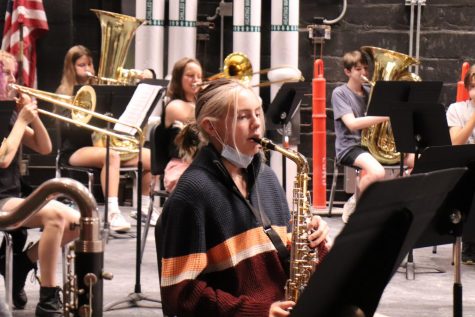
Former Lawrence High School orchestra teacher Rachel Dirks presented on this topic during the summer of 2021, speaking about her time as a middle and high school orchestra teacher. The research she did included lots of analyses directly related to LHS and its students.
After having multiple conversations with students, Dirks became curious about how students’ mental health was being affected by schools.
“I began wondering if these conversations I had shared with my students, both in high school and college, were just as common for my music teacher colleagues,” she said. “After digging deeper into this topic, what I discovered was a mental health crisis unlike any I could have imagined.”
According to Dirks, adolescence is a difficult time in human lives due to rapid changes in development. Add on to this an increase in mental health stressors like toxic social media cultures, social pressures and global issues such as climate change or COVID-19, students are under more mental strain than ever before.
These stressors require solutions from educational spaces. For music classes, simply being a safe place for students to go has been widely successful in helping create connections and anxiety releases that are crucial to being a modern teen.
“For me, music has brought me closer to my family since it is a big part of what we do together,” junior Kalea Daboda said. “To singing in the car or going to sing for a big gathering. Music always finds a way to bring people together. In high school, I earned great friends from doing music classes together.”
Jones has taught thousands of kids and is humbly aware of the effect his class can have on students who may be struggling with mental health.
“I’ve seen that many many times where this class, my class or music in general, has really kind of saved people,” Jones said. “They are on the planet because of this class. And I realized that and it’s a big responsibility, for sure.”
COVID’s effect on music
LHS assistant choral director Angela Loganbill directs the combined choirs and chamber orchestra before the annual Gala concert.
When the COVID-19 pandemic essentially shut down high school music programs across the country, these safe spaces were devastated, leaving in their wake a slew of students without the network that was crucial for their mental health.
“You cannot be a music ensemble unless you are together and online, you ain’t together, no matter how you spin it, there was no way that this is gonna work,” Jones said. “You can’t make music together. You can’t be social together. No matter if you see that person on the screen, it is not the same at all.”
Daboda was ready to drop choir after a difficult COVID-19 year, but after being approached by Dunn she decided to give it another try.
“I was not going to try out for choir because of how COVID-19 year went,” Daboda said. “Dr. Dunn came to me last minute and asked again and I ended up saying yes. I am so grateful I did say yes because I would have missed out on so much. I just want to say that teachers do care and want you here.”
For Daboda, staying in music class was a smart last-second decision, but others didn’t take the same path.
Massive numbers of students flocked away from music classes, either avoiding engagement or dropping the classes altogether. Online music learning could not offer the same level of engagement and opportunity no matter how hard the teachers tried.
The return of music performance
The unique mental health benefits of music classes came from the containment of the classes. In choir class, students put their phones in the back of the room so they can focus entirely on music for the class period. This sort of separation creates a place where students are not only allowed but forced to separate themselves from stressors to simply spend an hour making music. Online learning was not conducive to this atmosphere.
The second major benefit of music classes comes from their nature as co-curricular classes. Out-of-school events, practices and performances allow them to create social bonds similar to an athletics team. During COVID-19 lockdowns, these performances were abandoned altogether or heavily scaled back, gutting the constant social connection needed to form the deep bonds.
As these sorts of performance and social opportunities began to restart the past few months, the benefits were instantly felt by students.
Teachers noticed a new hunger and drive for performance from students after having a year without them.
“What used to be another thing to take up your time, or one more event to get through before winter break, has now become a chance to do something exciting and unique,” current LHS orchestra teacher Mariah Barnett said. “Something that we have missed for the last year and a half. A chance to perform together again and make music. Experience the feeling of putting in a lot of time and hard work for a great show. There is nothing like it.”
The ability to form and mold communities is a crucial tenet of social bonding and creating spaces that are helpful for student mental health.
“Each ensemble has their own personality, their own sense of belonging and their own classroom community,” Barnett said. “They get to build this space that is uniquely their own and when students figure that out it makes the class so much better. This has been so important for kids to have when being back in person after the pandemic. They need a space in the school that is theirs, that they feel safe and that they can be whomever they want to be.”
For lots of teachers, their role includes a lot more than just educating. Especially those who teach classes with such a strong community focus like a music class. The relationship between teachers and students in those roles goes both ways.
“When I first started teaching I did not think that my job would be so closely tied to students’ well-being or their mental health,” Barnett said. “Probably a naive perspective to have, honestly. Many days I feel more like a parent or counselor than I do an orchestra teacher, but [I] wouldn’t change a thing about it. The enthusiasm, excitement and enjoyment that I see students receiving from making music and from being in orchestra is all I need. They make coming to school everyday, even in a pandemic, worthwhile and I am so grateful for all of my students.”
For Dirks, as a longtime music educator, cultivating these music safe spaces is a crucial role of teachers and faculty in the music department.
“Although we may feel unprepared to cope with specific mental health concerns,” she said, “we can provide activities that reduce stress and anxiety in our classrooms that are authentic to who we are individually and as a music community.”
While enrollment at Lawrence High School has stayed fairly constant during the COVID-19 pandemic, music classes at LHS have seen a staggering 50% drop in enrollment with ensembles having to heavily adapt their usual practices just to survive.
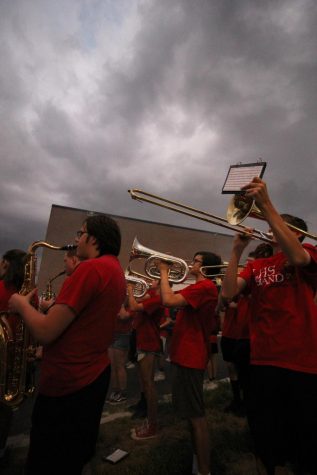
This lack of engagement creates the possibility for severe mental health concerns among the student body. Some students find engagement in other activities like athletics which can offer many similar benefits, but many of the unique benefits to music are lost, and most worryingly, students who have chosen to simply not engage in school activities as a whole could be at risk of isolation without the connection that music classes have offered in the past.
Encouraging engagement in music classes, especially for those without other comparable spaces, will be a crucial task for educators and administrators in the coming years.
Students that are heavily involved in music classes recommend getting involved for all of their peers, regardless of background.
“Everyone should try some type of musical activity in high school,” Thomas said. “Even if you start out with zero experience, our directors have so much to teach, and the environment is so friendly and encouraging. Musicians are the kindest and most successful students in school.”
For musicians, it has been an incredibly difficult year and a half. But as music ensembles begin to meet together and perform again, the dynamic power of music is being felt in the lives of students once more.
“The people who are here are loving rehearsing, they love doing it,” said Jones. They love being part of it and they’re happy to be back together and doing what we want, you know, which is making music together. So it feels like we’re back.”

